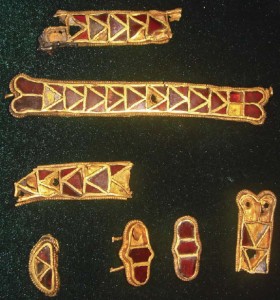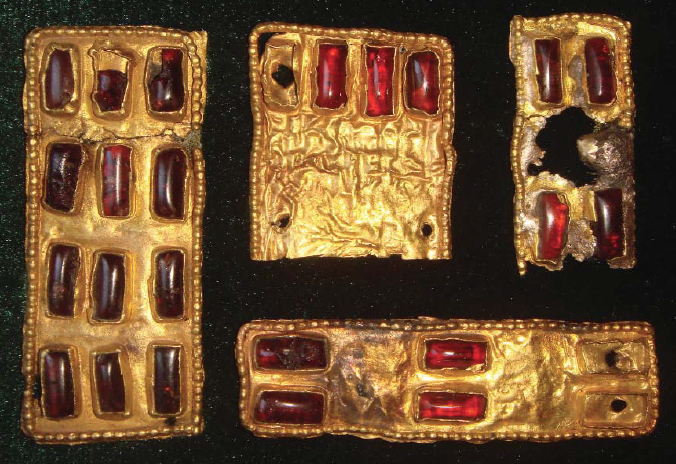Technical examinations of the gold used in the different artifacts found in the Hunnic treasure from Nagyszéksós show a variety of sources and witness to the widespread perambulations of the Huns
The Hunnic treasure from Nagyszéksós was found in 1926 in a vine-yard just outside Szeged in Hungary. With exception of a few pieces it is currently stored in the local museum. Up till now it has (except for a few pieces in Budapest) been displayed; neither has it been technically described.
The find consists of 157 golden objects and fragments many of which have been decorated with inlays of red glass as well as gemstones such as garnet, rock crystal and perhaps amethyst. The treasure is most probably what is left of a funerary pyre of – perhaps – the chieftain Uptar, who together with Rua (or Ruga) was the predecessor of Attila. The finds have been dated to around 430 AD. Funerary pyres accompanied by ritual banquets were the special prerogative of males of the royal family (females, even socially important, were buried without the ritual burning of gifts on pyres).
It is believed that the treasure was probably larger, as the children for along time had played with small shiny objects, before the archaeologists excavated the site.

This paper by Alessandra Giumlia-Mair presents the results of 280 X-ray Fluorescence Spectronomy (XRF) analyses and 290 magnified examinations carried out on most of the objects belonging to the hoard. The primary object was to investigate the metallurgical composition etc. of the pieces in the hoard.
Through these examinations a variety of different metallurgical compositions were found, witnessing to the multiple ethnicities and or trade-networks characterising the “Hunnic Kingdom”.
It is commonly thought that the gold used by the Huns came from molten and re-used Roman Coins, received as tribute. Every year the Romans had to pay 160 kg of gold to Ruga. Later Attila raised this to app. 300 kg of gold per year. This gold was characterised by a fineness of 95 – 99%; thus it is possible that some of the gold used for the torques, the large buckles and most of the gold sheet might have come from the Romans. However a different class of gold alloys was used for the objects with cloisonné decoration. Such ornaments are commonly considered to be typical products of artisans working for the Germanic tribes, such as the Visigoths, Heruls, Gepides, Burgundians, Franks and Suebians. Parts of these tribes were pushed westward by the Huns after 400 AD and some of the cloisonné ornaments in the treasure may be “Germanic” produce pillaged from or traded with these groups of people. Added to this should be yet another group of objects, traditionally seen as characteristic of the Huns, the plates with square garnets or other red stones, usually fitted to saddles, horse fittings, weapons and representative belts. A fourth group consists of typical Alanic horsefittings and finally there are some objects most probably of Iranian origin.
Thus the examination shows a variety of possible sources for the Hunnic wealth as opposed to the traditional explanation, that it was all the result of extraction from the Romans. However, in the article a couple of artefacts are discussed, where the alloy obviously had been chosen carefully to create pieces which might carry a heavy use; for instance this is the case with the handle of the so-called Nogaika or Kamcha, the tradional Hunnic horse-whip.
However, Alessandra Giumlia-Mair concludes that the sourcing of the gold was diverse and a witness to the wide network of the Hunnic Tribe and its allies, moving from Central Asia towards the Roman Limes in the beginning of the 5th century. But she also calls for a comparative analysis of other Hunnic Gold
SOURCE:
Metallurgy and Technology of the Hunnic Gold Hoard from Nagyszeksos
By Alessandra Giumlia-Mair, Owner and director at AGM Archeoanalisi
In: The Silk Road 2013, Vol 11, pp. 12 – 37
